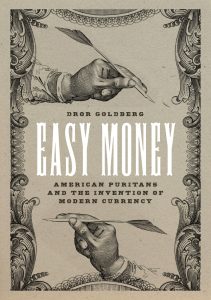Five Questions with Dror Goldberg, author of “Easy Money: American Puritans and Invention of Modern Currency”
In Easy Money: American Puritans and the Invention of Modern Currency, Dror Goldberg tells the lesser-known history of how modern money was invented in a seventeenth-century Massachusetts colony while tracing its roots in today’s financial systems. Read on below for an interview with the author about his research and what lessons we can apply from the early days of currency to today’s crypto world.
While you were working on this project, what did you learn that surprised you the most?
I was surprised to learn how interesting early American history was. As a foreign economist, without a British or Christian background, all I knew about the colonial period before starting this project was Mayflower, Thanksgiving, and the Salem witch trials.
Later, I was surprised to learn how valuable my perspective could be, exactly because I was such a complete outsider. The subject of my investigation—a currency issued by Massachusetts in 1690—has been known to historians for centuries. The perspective of an economist (with legal training) was necessary to appreciate the global historical significance of this invention. This culturally distanced perspective allowed me to investigate and explore this history with fewer preconceived notions about England vs. America, a preference for a region within America or a Christian denomination, or a penchant for seeing everything as leading to the American Revolution.
Why and how did colonial Massachusetts invent modern money?
The “why” and “how” relate to the need to invent that money and to the ability to invent that money, respectively. Why did Massachusetts need to invent a new type of money? To begin with, like so many other early modern governments, it couldn’t pay its debts to soldiers. Moreover, Massachusetts was in a peculiar, temporary constitutional moment: It was lobbying England for a new charter and knew that England would not allow it to issue full-fledged money (of metal or paper). It, therefore, had to invent something that didn’t look like real money.
How was Massachusetts able to invent a new type of money? Massachusetts was the commercial, financial, and intellectual center of English America. Harvard scholars read hints in Plato, Aristotle, and the contemporary Hobbes, which could have led them to understand that an object could be money simply if the issuing government accepted it for its own taxes. Boston merchants were very experienced at paying debts with objects other than coins, and they learned from experience that objects acceptable for tax payments could gain general circulation as money. Who needs gold when you have taxes?
Why is it that the money we use, and the political mechanism that controls it, are so similar to those of 1690 Massachusetts?
Massachusetts created an alternative to metallic money and metal-backed paper money. This alternative fit wartime episodes as in 1690 and was implemented during many wars since then, as in the Civil War. To prevent inflation, this legal tender money was regularly abandoned after wars in favor of gold. The World Wars of the twentieth century, with the Great Depression in the middle and the welfare state later, increased government expenditures so much that gold was doomed. Since 1971 gold has played no role in the monetary system.
The English colonies and the later United States have struggled for centuries with the proper way to control the money supply. In 1690 Massachusetts it was obvious that a committee should issue the new money because everything of importance was performed by committees. The monetary committee had a slight majority of members representing the executive and legislature over those representing the private sector. These checks and balances worked well, but the later United States forgot this successful experiment in the three times it established a central bank. The First and Second Banks of the United States were private and centralized while the original Federal Reserve System was mostly private and very decentralized. All three experiments were terminated within two decades. The Federal Reserve still exists but in a modified form, in which policy resides in a Federal Open Market Committee, where, as in 1690, the representatives of the executive and legislature have a slight majority over the private sector. This political mechanism has survived for almost a century because it gave the private sector the proper role that the American constitutional tradition has generally granted it.
Why do so few use crypto “currencies” in shopping?
Crypto “currencies” suffer from numerous problems in their competition with government-issued currencies. One reason is that there are so many of them, so it’s hard to know which one to choose. This coordination problem is augmented by the fact that such assets are not legal tender for taxes. This is the most defining feature that separates them from all modern government-issued currencies, all of which follow the 1690 example. There is no reason for governments to accept bitcoin or any other such assets for taxes at the expense of their own currencies, which they produce at negligible costs. Therefore, anyone who wants to conduct his or her business with bitcoin finds that he or she must continuously convert bitcoin to government money in order to pay taxes. As long as inflation is not terribly high and the welfare state demands large and frequent tax payments, all crypto “currencies” will fail to replace government-issued legal tender money – whether the latter is made of cheap metal, paper, or digits.
What do you hope most readers will take away from your book?
The Puritans were no cartoon characters of stern, disciplined fanatics—they were real people, who tried, with as many moral errors as other humans, to deal with the difficult circumstances of their lives. They were highly skilled, determined individuals who came up with a brilliant invention that profoundly affected the modern era and still affects our own lives. It is not a coincidence that the United States grew in large part out of that old Massachusetts. Long before the Tea Party, the people of Massachusetts audaciously broke free of one of the Old World’s most sacred institutions—metal-based money—and showed the way to the future.

Dror Goldberg is a senior faculty member in the Department of Management and Economics at the Open University of Israel.
Easy Money is available now from our website or your favorite bookseller.
